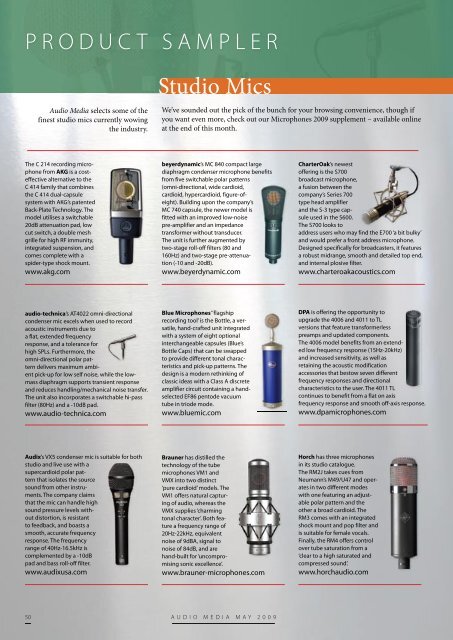Renew Your Audio Media Subscription for 2009!
Renew Your Audio Media Subscription for 2009!
Renew Your Audio Media Subscription for 2009!
Create successful ePaper yourself
Turn your PDF publications into a flip-book with our unique Google optimized e-Paper software.
PRODUCT SAMPLER<br />
50<br />
<strong>Audio</strong> <strong>Media</strong> selects some of the<br />
finest studio mics currently wowing<br />
the industry.<br />
The C 214 recording microphone<br />
from AKG is a costeffective<br />
alternative to the<br />
C 414 family that combines<br />
the C 414 dual-capsule<br />
system with AKG’s patented<br />
Back-Plate Technology. The<br />
model utilises a switchable<br />
20dB attenuation pad, low<br />
cut switch, a double mesh<br />
grille <strong>for</strong> high RF immunity,<br />
integrated suspension, and<br />
comes complete with a<br />
spider-type shock mount.<br />
www.akg.com<br />
audio-technica’s AT4022 omni-directional<br />
condenser mic excels when used to record<br />
acoustic instruments due to<br />
a flat, extended frequency<br />
response, and a tolerance <strong>for</strong><br />
high SPLs. Furthermore, the<br />
omni-directional polar pattern<br />
delivers maximum ambient<br />
pick-up <strong>for</strong> low self noise, while the lowmass<br />
diaphragm supports transient response<br />
and reduces handling/mechanical noise transfer.<br />
The unit also incorporates a switchable hi-pass<br />
filter (80Hz) and a -10dB pad.<br />
www.audio-technica.com<br />
Audix’s VX5 condenser mic is suitable <strong>for</strong> both<br />
studio and live use with a<br />
supercardioid polar pattern<br />
that isolates the source<br />
sound from other instruments.<br />
The company claims<br />
that the mic can handle high<br />
sound pressure levels without<br />
distortion, is resistant<br />
to feedback, and boasts a<br />
smooth, accurate frequency<br />
response. The frequency<br />
range of 40Hz-16.5kHz is<br />
complemented by a -10dB<br />
pad and bass roll-off filter.<br />
www.audixusa.com<br />
Studio Mics<br />
We’ve sounded out the pick of the bunch <strong>for</strong> your browsing convenience, though if<br />
you want even more, check out our Microphones <strong>2009</strong> supplement – available online<br />
at the end of this month.<br />
beyerdynamic’s MC 840 compact large<br />
diaphragm condenser microphone benefits<br />
from five switchable polar patterns<br />
(omni-directional, wide cardioid,<br />
cardioid, hypercardioid, figure-ofeight).<br />
Building upon the company’s<br />
MC 740 capsule, the newer model is<br />
fitted with an improved low-noise<br />
pre-amplifier and an impedance<br />
trans<strong>for</strong>mer without transducer.<br />
The unit is further augmented by<br />
two-stage roll-off filters (80 and<br />
160Hz) and two-stage pre-attenuation<br />
(-10 and -20dB).<br />
www.beyerdynamic.com<br />
Blue Microphones’ ‘flagship<br />
recording tool’ is the Bottle, a versatile,<br />
hand-crafted unit integrated<br />
with a system of eight optional<br />
interchangeable capsules (Blue’s<br />
Bottle Caps) that can be swapped<br />
to provide different tonal characteristics<br />
and pick-up patterns. The<br />
design is a modern rethinking of<br />
classic ideas with a Class A discrete<br />
amplifier circuit containing a handselected<br />
EF86 pentode vacuum<br />
tube in triode mode.<br />
www.bluemic.com<br />
Brauner has distilled the<br />
technology of the tube<br />
microphones VM1 and<br />
VMX into two distinct<br />
‘pure cardioid’ models. The<br />
VM1 offers natural capturing<br />
of audio, whereas the<br />
VMX supplies ‘charming<br />
tonal character’. Both feature<br />
a frequency range of<br />
20Hz-22kHz, equivalent<br />
noise of 9dBA, signal to<br />
noise of 84dB, and are<br />
hand-built <strong>for</strong> ‘uncompromising<br />
sonic excellence’.<br />
www.brauner-microphones.com<br />
AUDIO MEDIA MAY <strong>2009</strong><br />
CharterOak’s newest<br />
offering is the S700<br />
broadcast microphone,<br />
a fusion between the<br />
company’s Series 700<br />
type head amplifier<br />
and the S-3 type capsule<br />
used in the S600.<br />
The S700 looks to<br />
address users who may find the E700 ‘a bit bulky’<br />
and would prefer a front address microphone.<br />
Designed specifically <strong>for</strong> broadcasters, it features<br />
a robust midrange, smooth and detailed top end,<br />
and internal plosive filter.<br />
www.charteroakacoustics.com<br />
DPA is offering the opportunity to<br />
upgrade the 4006 and 4011 to TL<br />
versions that feature trans<strong>for</strong>merless<br />
preamps and updated components.<br />
The 4006 model benefits from an extended<br />
low frequency response (15Hz-20kHz)<br />
and increased sensitivity, as well as<br />
retaining the acoustic modification<br />
accessories that bestow seven different<br />
frequency responses and directional<br />
characteristics to the user. The 4011 TL<br />
continues to benefit from a flat on axis<br />
frequency response and smooth off-axis response.<br />
www.dpamicrophones.com<br />
Horch has three microphones<br />
in its studio catalogue.<br />
The RM2J takes cues from<br />
Neumann’s M49/U47 and operates<br />
in two different modes<br />
with one featuring an adjustable<br />
polar pattern and the<br />
other a broad cardioid. The<br />
RM3 comes with an integrated<br />
shock mount and pop filter and<br />
is suitable <strong>for</strong> female vocals.<br />
Finally, the RM4 offers control<br />
over tube saturation from a<br />
‘clear to a high saturated and<br />
compressed sound’.<br />
www.horchaudio.com
















